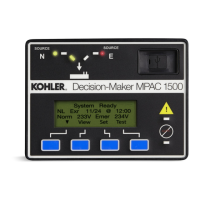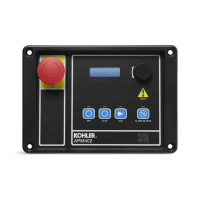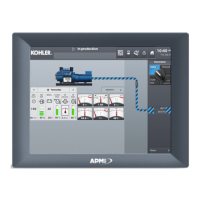TP-6714 4/1080 Section 5 Setup
5.12.3 Input Functions
Available input functions are shown in Figure 5-18.
Some inputs will trigger an indicator LED on the user
interface and/or display a message on the LCD screen
when they are activated.
All of the inputs may be assigned to either one or both of
the common alarms.
Note: Some models have factory-set input functions as
shown in Figure 5-17. Do not change these
settings.
Model or
Factory-Installed
Accessory
Factory Setting
Bypass/isolation Models Bypass Contactor Disable
Service Entrance Models Inhibit Transfer
Load Shed Kit Forced Transfer to OFF
Figure 5-17 Factory Set Inputs
Forced Transfer to OFF Input. This function requires
the load shed accessory installed on a programmed-
transition model transfer switch. The load shed
accessory is not available for bypass/isolation switches.
Activation of this input signals the transfer switch to
transfer immediately from Source E to the OFF position.
The transfer switch then transfers to Source N if it is
available, executing the applicable time delays.
See Section 8.11 for more information about the load
shed (forced transfer to OFF) function.
Remote Monitored Inputs. There are four remotely
monitored input functions. These functions can be
assigned to any of the inputs on either the main logic
board or standard/high voltage/high current I/O boards.
The state of any or all of these inputs can be monitored
via Modbus messages only (i.e. through Monitor III
software or other Modbus application).
Peak Shave/Area Protection Input. Starts the
generator set and transfers to the standby source,
ignoring the engine start time delay. The pre/post-
transfer, delayed-transition time delays, and in-phase
monitor will be active if enabled.
When the peak shave signal is removed, the load
transfers back to the preferred source. The pre/post-
transfer, delayed-transition, and engine cooldown time
delays, along with the in-phase monitor if enabled, will
be executed.
If the standby source is lost during peak shave, the unit
will transfer back to the preferred source.
See Section 5.14.8 for information about the Peak
Shave TD Bypass.
Remote Bypass Time Delay Input. Allows a remote
signal to end an active time delay. The signal ends only
the time delay that is active at the time the signal is
applied. Repeated signals are required to end
additional time delays. Does not end the
programmed-transition time delays or an exerciser run.
Programmable Inputs * LED
«
LED
Display Message
Bypass Contactor Disable* None Flashing Bypass Contactor Disable *
Forced Transfer to OFF* (programmed-transition
models only; requires load shed accessory; not
applicable to bypass/isolation switches)
None Flashing Forced Off
Inhibit Transfer* (maintenance mode) None Flashing Inhibit Transfer
Low Battery Voltage Steady None Low Battery Voltage
Peak Shave Mode None None Peak Shave
Remote End Time Delay None None None
Remote Common Alarm Steady None Remote Common Alarm
Remote Test None None Normal test sequence screens. See
Section 3.10.
Remote Monitor In #1--4 None None None
Three-Source System Disable None None None
* See Figure 5-17 for factory-set input functions for selected models. Do not change the factory settings.
Figure 5-18 Available Programmable Inputs

